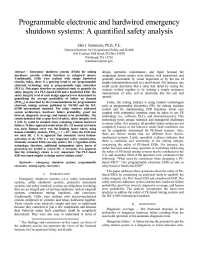Mining Publication: Programmable Electronic and Hardwired Emergency Shutdown Systems: A Quantified Safety Analysis
Original creation date: July 2007
Emergency shutdown systems (ESDs) for mining machinery provide critical functions to safeguard miners. Traditionally, ESDs were realized with simple hardwired circuits; today, there is a growing trend to use programmable electronic technology such as programmable logic controllers (PLCs). This paper describes an analytical study to quantify the safety integrity of a PLC-based ESD and a hardwired ESD. The safety integrity level (SIL) of each design approach was determined by quantifying the average probability of failure (in demand (PFDavg) as described by the recommendations for programmable electronic mining systems published by the National Institute for Occupational Safety and Health and the IEC 61508 international standard. The safety analyses addressed system architecture, hardware failure probability, proof test interval, diagnostic coverage, and human error probability. The results indicated that a same level of safety, SIL 3, could be attained when evaluating random ! hardware failures. Neither approach could attain SIL 3 if manual activation was used. Human error was the limiting factor where, using human reliability analysis, PFDavg < 1 X 10-1 thus, the ESD does not meet SIL 1. It is apparent that automatic verses human-activation of the ESD is a very important safety consideration. Manually actuated ESDs can only achieve SIL 1 regardless of the technology; therefore, additional independent safety layers of protection are needed to exceed SIL 1. Second, it is apparent that the technology choice is very important. The PLC-based ESD was much simpler to design and to validate safety.
Authors: JJ Sammarco
Peer Reviewed Journal Article - July 2007
NIOSHTIC2 Number: 20032480
IEEE Trans Ind Appl 2007 Jul-Aug; 43(4):1061-1068
See Also
- Development of Guidelines for Safely Managing Electrical Equipment and Systems in Underground Mines During Mine Emergencies and Other Abnormal Circumstances
- Emergency Management
- Emerging Technologies: Aiding Responders in Mine Emergencies and During the Escape From Smoke-Filled Passageways
- Fire Response Preparedness for Underground Mines
- Knowledge Management and Transfer for Mine Emergency Response
- Leadership Characteristics in Escape from Three Underground Mine Fires
- Mine Rescue and Response
- Mobile Adaptable RF/IT Infrastructure - Experimental (MATRIX)
- An Oral History Analysis of Mine Emergency Response
- Refuge Alternatives in Underground Coal Mines
- Content source: National Institute for Occupational Safety and Health, Mining Program


 ShareCompartir
ShareCompartir
